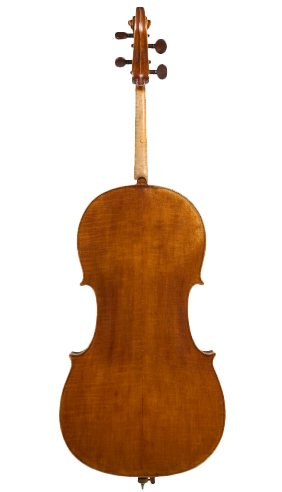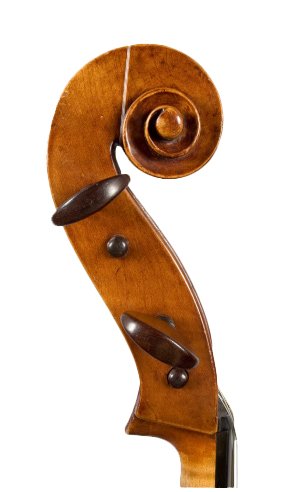Labelled: "Raffaele ed Antonio Gagliano Quodam Giovanni Napoli 1857"
Length of back: 730mm (Lot 30 in November 2008)
The Gagliano dynasty of Naples is possibly the longest and most prolific of any of the Italian violin making families, overtaking the Amati at least in sheer numbers. No fewer than eleven violin makers bore the Gagliano name, from Alessandro in the very early eighteenth century to the last of the line, the brothers Raffaele and Antonio. In that time, they encompassed the great and the good, but also the cheap and the cheerful. In real terms they describe the arc of lutherie in the classical period from its beginnings in fine artisanship and a rich but possibly restricted clientele, to virtual mass production, still handwork, but reduced to quality-paring economies and the demands of the wider and more competitive market of the nineteenth century.



Raffaele and Antonio were respectively the second and third sons of Giovanni Gagliano. Their elder brother Nicola did work individually, but it seems not for very long; his instruments are relatively rare, and date from about 1800 to 1825. His two brothers, by contrast, were prolific, and flourished throughout the first half of the nineteenth century. Their lineage is quite complex. Their father, Giovanni, whose name is preserved on their label 'Raffaele ed Antonio Gagliano Quondam Giovanni', was himself one of four violin making brothers. Two of them, Giuseppe and Antonio, also worked in partnership, while the eldest, Ferdinand followed a separate career. Their father was Nicolo Gagliano, held by some to be the finest maker of the whole family, but Ferdinand himself seems to have been apprenticed to his uncle Gennaro, who was a very gifted and adaptable craftsman, possibly more refined and sophisticated even than Nicolo. Alessandro, the father of Nicolo and Gennaro, and the grandfather of Raffaele and Antonio, was a distinctive and characterful maker, whose work belongs firmly in an earlier chapter of violin making, clothed in rich oil varnish and apparently independent in spirit and more freely influenced than the harder-varnished and more obviously Cremona- influenced work of his descendants.
Raffaele and Antonio obviously did have to work hard and quickly to compete with the torrential numbers of instruments available in the nineteenth century, coming from cottage industries in Germany and Bohemia. The signs are clear in the fabric of their instruments. They often lack purfling, a scratched and painted line substituting for the time-consuming inlay of veneers. The wood is often of plain appearance, and the scroll quickly carved, with little time for consideration of symmetry and balance. But the sound is more often than not marvellous. It is hard to imagine their heritage of experience would count for nothing, and what they did have was a good pattern, a good arching, and a basic technique that allowed them to get the best out of meagre materials.
There are many markers in an instrument that point out a Neapolitan origin. One of the more reliable is the use of beechwood in the structure. Although other Italian schools used it in similar ways, the combination of beechwood purfling and linings does seem to define the Gaglianos in particular. Another easily spotted feature is the arrangement of the pegs in the pegbox in pairs, the two outer strings separated from the inner two, sensibly allowing more space for the fingers to adjust them.
This cello illustrates the pitfalls of relying too much on prescriptive ideas for identification. While distinctly Neapolitan in design and execution, it has proper purfling, not a scratched imitation, and it is not beech, but three veneers of poplar. The large and coarsely shaped rib linings are predictably of beech however, and are fitted between pine corner blocks.
The head also follows expectation, with the C and A pegs sited closely together near the nut and the G and D pegs set at the upper end of the pegbox. The pegbox itself is very parallel in profile, the shoulders hardly deeper than the throat. The sloping shoulders are also distinctive- most Italian cellos retain the classically squared shoulders of Cremona. The button is very small, and the chamfer rather weak and irregular as it wends its way around the asymmetrical volutes.
The outline is typically narrow, with long centre bouts and projecting corners. The edgework is rather flat, but well-modelled. The arching is very low, with a slightly boxy aspect on the back. The fir-wood front bears long and graceful F-holes, very reminiscent of Guadagnini in style, the upper halves a little extended, but the lower wings broad and deeply fluted.
The varnish is clear and rust-red in colour, laid over quite a dark ground. It is slightly chippy and hard in texture, and almost certainly spirit based.
The Gagliano brothers were not unskilled, but circumstances probably restricted their opportunities to make the best of their heritage. Naples was well-populated with instrument makers, many specialising in the mandolin, but competition came from local families like the Ventapane and Vinaccia, as well as Northern Europe. The date on the label of this cello, 1857, marks the death of Raffaele, and Antonio continued for only a few years more. With his death, in or shortly after 1860, the long Gagliano dynasty which had defined the Neapolitan violin for over one and a half centuries finally came to an end.